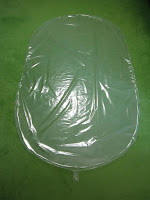Time: 07:00 GMT (09:00 CEST)
Place: Roznov pod Radhostem, CZ
Tracking: http://aprs.fi
This is a relaunch of the TT7B1 tracker that ended up in treetops about a week ago under a new envelope.
| Transmissions | ||
|---|---|---|
| Type | APRS | |
| Callsign | OK7DMT-1 | |
| Frequency | 144.39-145.57 | MHz |
| Period | 2 | min |
| Transmit Power | 12.5 | mW |
The packets are a combination of Base91 encoded position and custom telemetry data in the comment section of the packet. An online decoder and example packets can be found at this link. The tracker transmits on local APRS frequencies. In case of GPS failure, telemetry without position is transmitted. Packets also contain backlogged data from the past 7 days.
| Flight Parameters | ||
|---|---|---|
| Lifting Gas | hydrogen | |
| Envelope Volume | ~0.430 | m3 |
| Envelope Mass | 116.0 | g |
| Payload Mass | 18.6 | g |
| Free Lift | 7.2 | g |
| Neck Lift | 25.8 | g |
| Initial Ascent Rate | 0.90 | m/s |
| Expected Float Altitude | 11930 | m |
The balloon on this flight was a Mylar balloon shaped envelope 1.35m in diameter (flat) from a 40μm multilayer (PE/PA/EVOH/PA/PE) film. The making of the envelope is in detail described in this blog post. A calculator was used to obtain the flight parameters based on previously measured envelope volume, mass and payload mass. Due to issues with the pressurizing rig and short time, the balloon volume was not measured. Since the envelope was made with the same process, a figure from the previous balloon was used. Latest atmospheric sounding data (Prostejov, 20190921 0:00Z) were used to calculate the expected float altitude.
Initial ascent trajectory was modeled with CUSF Landing Predictor, while the long term float predictions with HYSPLIT Trajectory Model. The HYSPLIT prediction contains three altitude levels. One 500m below and another 500m above the expected float altitude.
The design of the tracker is in detail described in this and this blog posts. This time, the final touches consisted of securing an Energizer Ultimate Lithium AA primary battery (estimated lifetime ~60 days) to the tracker. The battery was covered in black electrical tape, and leads were soldered directly to the battery's terminals. Based on in-flight low temperature behavior of TT7B2, another layer of Glob Top epoxy was deposited on the tracker. This time, covering the whole top side including the GPS module. An initial 5 minute satellite search period was removed from the code, and the maximum duration of GPS fix reacquisition was lowered to 37 seconds. Also, minor remnants of the previous balloon remained glued to the external sensors cable as they were impossible to remove.
A pressure sensor and a thermistor were sealed inside the envelope, and the gas inlet was glued shut - this time with additional layers of film. Two thin magnet wire antenna radials were fastened to the balloon's circumferential weld. The lead connecting the battery to the tracker was soldered just before the launch.
Day 1: The balloon ascended at an average rate of 0.9m/s (maximum 1.9m/s) to an initial altitude of 10800m, about a kilometer below expectation. The initial ascent was very slow at an average of 0.66m/s to 1000m. The previous mishap, though, didn't repeat.
The balloon flew over the countries of Slovakia, Hungary and Romania. It was received by a large number of stations as these areas are well covered. The satellite images didn't show any thunderstorms nor any other high altitude clouds in the area.
Having seen the TT7B2's data, it became apparent shortly after the balloon began floating that it would follow the same path and eventually descend due to hydrogen leaking from the envelope. The balloon still maintained the same altitude for hours before it started its inevitable descent at 15:00 GMT. Currently, the best guess is that the glue doesn't do a good enough job sealing the inlet given the conditions. Although, other issues arising from the manufacturing process of the envelope can't be ruled out at this point.
All the received APRS packets can be found in this text file: TT7B1_packets.txt
And all the decoded live and backlogged data can be found in this csv file: TT7B1_data.csv

























































